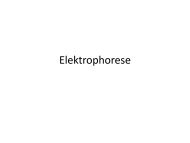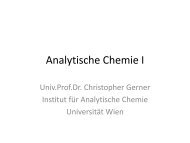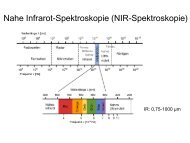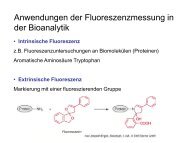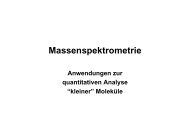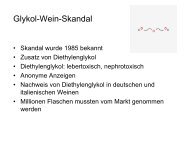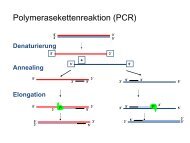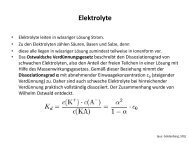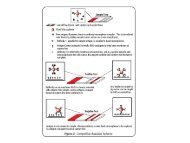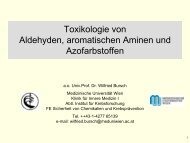Allgemeine Toxikologie II - Institut für Analytische Chemie
Allgemeine Toxikologie II - Institut für Analytische Chemie
Allgemeine Toxikologie II - Institut für Analytische Chemie
Sie wollen auch ein ePaper? Erhöhen Sie die Reichweite Ihrer Titel.
YUMPU macht aus Druck-PDFs automatisch weboptimierte ePaper, die Google liebt.
PHTHALATES<br />
DEHP Toxicological Evaluation (SCF 1994)<br />
Repeated dose toxicity, oral, rats<br />
- target organs: liver, kidney, testis<br />
- increase in liver weight: at 50 mg/kg/day<br />
peroxisome proliferation, NOEL: 5 mg/kd/day<br />
Carcinogenicity<br />
- not genotoxic<br />
- heptacellular adenoma/carcinoma (rat, mouse),<br />
tumor promotion<br />
Developmental/reproductive toxicity<br />
- embryo-fetotoxic and/or teratogenic in rodents<br />
Proposed mode of action (MOA) with key events<br />
of rodent liver tumors induced by PPARα ligands<br />
NPC<br />
Kupffer cells<br />
Klaunig et al.<br />
Crit.Rev.Tox,<br />
33(6),655,2003, modified<br />
Non-peroxisome<br />
lipid gene<br />
expression<br />
GJIC<br />
c<br />
PPAR agonist<br />
c<br />
Preneoplastic foci<br />
Clonal expansion<br />
PPAR-receptor<br />
Cell cycle, growth<br />
and apoptosis<br />
gene expression<br />
c<br />
Apoptosis<br />
Cell proliferation<br />
Tumors<br />
Peroxisome gene<br />
expression<br />
Peroxisome<br />
proliferation<br />
Oxidative<br />
stress<br />
DNA damage<br />
HEPATOCYTE<br />
Weight of key events leading to<br />
hepatic tumor.<br />
C, causal: required step for<br />
PPAR MOA, based on<br />
empirical evidence<br />
69<br />
70<br />
35



